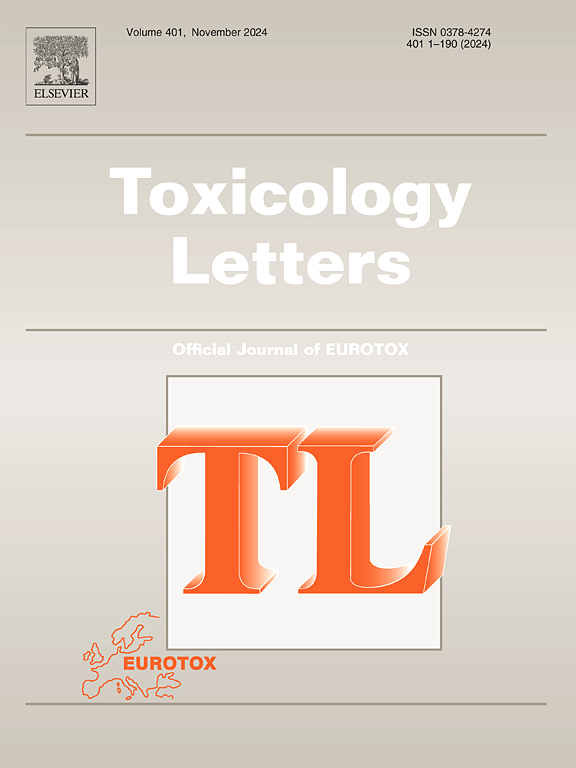Arsenic enhances endoplasmic reticulum stress via YTHDC1/AKR1C3 aix to promote the malignant transformation of human urothelial cells
IF 2.9
3区 医学
Q2 TOXICOLOGY
引用次数: 0
Abstract
Arsenic, a well-established carcinogen, is strongly associated with the development of multiple malignancies, including bladder, skin, and lung cancers. Epidemiological studies have revealed that elevated arsenic concentrations in water sources significantly increase the risk of bladder cancer (BC), which exhibits the highest relative risk among arsenic-induced cancers. Furthermore, patients exposed to arsenic show a greater propensity for developing high-grade malignant tumors. Nevertheless, the precise molecular mechanisms underlying arsenic-induced BC initiation and progression remain incompletely understood. Our experiments revealed a significant upregulation of AKR1C3 expression in human urothelial cells following arsenic exposure. Consistently, rats subjected to long-term arsenic-contaminated drinking water displayed a similar upregulation pattern in bladder epithelial tissues. The overexpression of AKR1C3 showed a pronounced ability to promote arsenic-induced malignant transformation of human urothelial cells, both in vitro and in vivo. Mechanistic studies revealed that arsenic stabilized AKR1C3 mRNA by upregulating YTHDC1, resulting in increased AKR1C3 protein levels. Further investigation into downstream mechanisms indicated that AKR1C3 amplifies endoplasmic reticulum (ER) stress by upregulating ER stress-sensing and transducing proteins—PERK, IRE1, and ATF6—thereby exacerbating the unfolded protein response (UPR). This sustained activation of the UPR enhances cellular adaptation to arsenic-induced stress, perpetuating its oncogenic effects and ultimately driving the malignant transformation of urothelial cells. Our findings delineate the specific role and mechanistic basis of AKR1C3 in arsenic-induced bladder carcinogenesis, providing a theoretical framework for developing preventive and therapeutic strategies against this malignancy.
砷通过YTHDC1/AKR1C3基因增强内质网应激,促进人尿路上皮细胞恶性转化。
砷是一种公认的致癌物,与多种恶性肿瘤的发生密切相关,包括膀胱癌、皮肤癌和肺癌。流行病学研究表明,水源中砷浓度升高会显著增加膀胱癌(BC)的风险,膀胱癌是砷引起的癌症中相对风险最高的。此外,暴露于砷的患者更倾向于发展为高级别恶性肿瘤。然而,砷诱导的BC起始和进展的精确分子机制仍然不完全清楚。我们的实验揭示了砷暴露后人类尿路上皮细胞中AKR1C3表达的显著上调。长期饮用砷污染的饮用水的大鼠在膀胱上皮组织中也表现出类似的上调模式。在体外和体内,AKR1C3的过表达显示出明显的促进砷诱导的人尿路上皮细胞恶性转化的能力。机制研究表明,砷通过上调YTHDC1来稳定AKR1C3 mRNA,导致AKR1C3蛋白水平升高。对下游机制的进一步研究表明,AKR1C3通过上调内质网(ER)应激感知和转导蛋白(perk、IRE1和atf6)来放大内质网(ER)应激,从而加剧未折叠蛋白反应(UPR)。UPR的持续激活增强了细胞对砷诱导应激的适应性,使其致癌作用永续存在,并最终驱动尿路上皮细胞的恶性转化。我们的研究结果描述了AKR1C3在砷诱导膀胱癌发生中的特定作用和机制基础,为制定针对这种恶性肿瘤的预防和治疗策略提供了理论框架。
本文章由计算机程序翻译,如有差异,请以英文原文为准。
求助全文
约1分钟内获得全文
求助全文
来源期刊

Toxicology letters
医学-毒理学
CiteScore
7.10
自引率
2.90%
发文量
897
审稿时长
33 days
期刊介绍:
An international journal for the rapid publication of novel reports on a range of aspects of toxicology, especially mechanisms of toxicity.
 求助内容:
求助内容: 应助结果提醒方式:
应助结果提醒方式:


